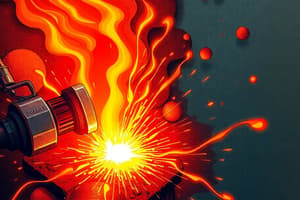Podcast
Questions and Answers
What is the primary reason ferrous metals require protective finishes?
What is the primary reason ferrous metals require protective finishes?
- To prevent corrosion (correct)
- To increase their malleability
- To enhance their conductivity
- To improve their tensile strength
Which metal alloy is known for being strong, ductile, and a good conductor of heat?
Which metal alloy is known for being strong, ductile, and a good conductor of heat?
- Bronze
- Brass (correct)
- Stainless Steel
- Low Carbon Steel
What is the primary characteristic of high carbon steel?
What is the primary characteristic of high carbon steel?
- Hardness and brittleness (correct)
- High malleability
- High tensile strength
- High ductility
What is the primary application of bronze?
What is the primary application of bronze?
What is the primary purpose of metal finishing?
What is the primary purpose of metal finishing?
What is the primary characteristic of stainless steel?
What is the primary characteristic of stainless steel?
What is the primary application of cast iron?
What is the primary application of cast iron?
What technique is used to create a protective black oxide layer on metal surfaces?
What technique is used to create a protective black oxide layer on metal surfaces?
Which of the following is NOT a characteristic of non-ferrous metals?
Which of the following is NOT a characteristic of non-ferrous metals?
What is the primary characteristic of low carbon steel?
What is the primary characteristic of low carbon steel?
What is the property that makes brass an excellent heat conductor?
What is the property that makes brass an excellent heat conductor?
What is the primary advantage of brass?
What is the primary advantage of brass?
Which metal is ideal for bearings due to its low friction?
Which metal is ideal for bearings due to its low friction?
What is the primary use of silver?
What is the primary use of silver?
What is the characteristic of copper that makes it useful for plumbing and central heating applications?
What is the characteristic of copper that makes it useful for plumbing and central heating applications?
What is the primary application of stainless steel?
What is the primary application of stainless steel?
Flashcards are hidden until you start studying
Study Notes
Metal Finishing
- The purpose of metal finishing is to clean, polish, and enhance the surface of metals in both functional and visual aspects.
- It is the final touch of the manufacturing process, ensuring environmental protection and heightened aesthetic appeal.
- Popular metal finishing techniques include electroplating, anodizing, powder coating, hot blackening, brushing, sandblasting, and buff polishing.
Ferrous Metals
- Definition: Metals containing iron and exhibiting magnetic properties.
- Characteristics: Prone to rust, requiring protective finishes to prevent corrosion.
- Examples and applications:
- Cast Iron: brittle if thin, strong compressive strength, good electrical and thermal conductivity. Used for gates, manhole covers, drains, and vices.
- High Carbon Steel (Tool Steel): hard and brittle, less malleable than mild steel. Good electrical and thermal conductor. Used for tools, screwdrivers, and chisels.
- Low Carbon Steel or Mild Steel: ductile and tough, easy to shape, braze, and weld. Good conductor of heat and electricity. Popular for nuts and bolts, screws, bicycle frames, and car parts.
Non-Ferrous Metals
- Definition: Metals that do not contain iron and are not magnetic.
- Characteristics: Do not rust.
- Examples and applications:
- Aluminium: lightweight, malleable, and strong. Good conductor of heat and electricity. Used in drinks cans, cycle frames, and saucepans.
- Copper: very malleable, excellent conductor of electricity and heat. Used in plumbing and central heating applications.
- Silver: precious metal used in jewelry. Soft and malleable when hot, highly corrosion-resistant, and a good conductor.
Alloys
- Brass: strong, ductile, and a good conductor of heat. Used for taps, door fittings, hinges, locks, and musical instruments.
- Bronze: hard and corrosion-resistant. Used for bearings, outdoor components, and nautical applications.
- Stainless Steel: shiny silver when polished, hard and tough. Resistant to stains and corrosion. Used in kitchen sinks, cutlery, hospital equipment, architecture, aerospace, and transport.
Properties of Metals
- Hardness: a metal's ability to withstand friction and abrasion.
- Toughness: how well a metal can resist fracturing when force is applied.
- Elasticity: the rate at which a metal distorts in size and shape under stress.
- Conductivity: how well a metal allows electricity or heat to flow through it.
- Ductility: the ability of the metal to be drawn or deformed without fracture.
- Tensile strength: the amount of load a metal can withstand before failure.
- Malleability: the metal's ability to be bent or shaped easily.
Studying That Suits You
Use AI to generate personalized quizzes and flashcards to suit your learning preferences.




